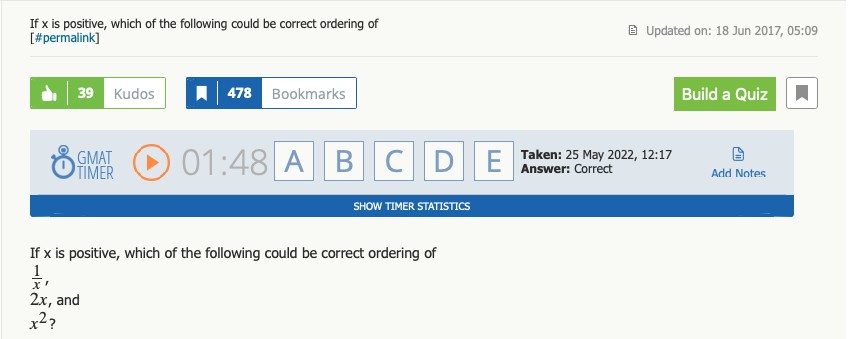PyjamaScientist wrote:
Hi
IanStewart,
Here I am troubling you again.
This question has intrigued me time and time again in terms of what it actually tests. We know now that GMAC is not interested in testing our maths skills but rather reasoning skills. So, how does one go about solving this in a manner where he/she does not have to write down a bunch of inequalities, do number picking and square root approximations and then reach to the answer.
As there's no one better than you when it comes to maths reasoning, I wonder how you'd look at such questions and how you'd go about solving them.
Hello,
PyjamaScientist. I happened to come across this question by chance, combing through the New Posts section in search of a question I had not attempted. Since I was sitting outside enjoying a sunny day, I did not want to go in and grab my noteboard and markers, so I used a little number sense to reason my way to the correct answer. It took me 1:48, as you can see in the attached screenshot.
Attachment:
 Screen Shot 2022-05-25 at 12.28.22.png [ 54.23 KiB | Viewed 2227 times ]
Screen Shot 2022-05-25 at 12.28.22.png [ 54.23 KiB | Viewed 2227 times ]
Please note that I am not disagreeing with the excellent response you have received by
IanStewart above. I would defer to Ian in any mathematical area the exam tests. I am more of a scientist at heart (perhaps like you, if your namesake is any indication), someone who enjoys testing an idea in search of an underlying truth or tendency. That said, the following is how I answered the question with confidence in under 2 minutes. If I am repeating something that someone else has written above, it is because I have not looked at the community dialogue yet (apart from your post and the response to it, of course).
Quote:
If x is positive, which of the following could be the correct ordering of 1/x, 2x and x^2 ?
I. \(x^2<2x<\frac{1}{x}\)
II. \(x^2<\frac{1}{x}<2x\)
III. \(2x<x^2<\frac{1}{x}\)
(A) None
(B) I only
(C) III only
(D) I and II only
(E) I II and III
Statement I: Any time I see
positive and x^2 as the lowest value in an inequality, I think of a fraction between 0 and 1, because anything greater than 1 will grow larger by squaring. Confession (in light of the above post): I did choose 1/2 to test. I did so because I did not want to work with anything complex in my head, and it "looked" right.
\((\frac{1}{2})^2<2(\frac{1}{2})<\frac{1}{(0.5)}\)
\(\frac{1}{4}<1<2\)
TRUEI dumped answer choices (A) and (C).
Statement II: I wanted to focus on the first half of the compound inequality, specifically on how I could get these two unknowns to be
as close as possible to each other while being mindful of the fact that 2x had to be greater than both. They could not get any closer to each other than 1:
\((1)^2=\frac{1}{(1)}\)
Now, since
x does not have to be an integer, I reasoned that if it were something
close to 1, such 0.999, the difference would be good enough for the inequality:
\((0.999)^2 < 1\) and
\(\frac{1}{(0.999)} > 1\)
I did not bother figuring out the exact values. A little number sense was good enough. Of course, 2x would be close to 2 using the same input value.
Since Statement II could be
TRUE, I eliminated answer choice (B).
Statement III: I pursued the same line of logic as before, focusing on the first half of the compound inequality:
\(2x<x^2\)
I wanted to get these values to be as close as possible to each other before considering the rest. Of course, if x = 2, we would get an equation:
\(2(2)=(2)^2\)
Thus, I wanted to pursue something close to 2 that would make the inequality true, something like 2.001.
\(2(2.001)<(2.001)^2\)
Again, the exact values were unimportant. But when I looked at the rest of the compound inequality, I could see that my input value would not work:
\(\frac{1}{(2.001)}\)
That would be close to a half, nowhere near as great as 4. I did not bother going any further, since I could only complicate matters by revisiting the earlier inequality (e.g., testing fractions). I selected answer choice (D).
In retrospect, I suppose my tutoring experience kicked in, and I pursued the line of reasoning that Ian outlined in one of his bullet points: "quickly imagine extreme values of x, to see if any items are obviously true." Extreme values do not have to be gigantic or minuscule. They can simply be numbers that you know would produce similar but slightly different outcomes. For instance, if we are not allowed to test 1, what about 0.99999999... or 1.00000000... with a 1 at the end, numbers that would effectively behave like a 1? These are the sorts of extremes I often pursue, since they are easy to work with in my head and can reveal larger truths or tendencies in many algebra or inequality problems.
If you have read this far, thank you for paying attention to the response no one asked for. I am not a Quant Expert, even if I aspire to be one.
- Andrew
















